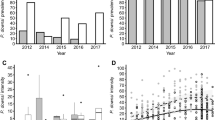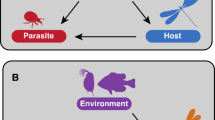Abstract
Identifying drivers of interspecific differences in trait plasticity is a major goal in ecology and evolution. For instance, understanding why species invest in constitutive or induced defenses against pathogens is critical for developing accurate models of host-parasite interactions. The adaptive plasticity hypothesis (APH) suggests that, due to costs associated with plasticity, species with greater heterogeneity in their association with an enemy should be more likely to exhibit a plastic (i.e., induced) defense. Here, I tested whether the APH can explain variation among eight co-occurring anuran species in a plastic defense (change in activity level after parasite exposure) against a common trematode parasite (Digenea: Echinostomatidae). The species examined vary in life history, habitat use and phenology—traits that influence the frequency of encounters with parasites in natural ponds. Laboratory experiments were used to measure the proportional change in species’ activity in response to parasites and infection levels, and experimental results were then coupled to data from a field survey. Consistent with the APH, the activity change was greatest for species that vary most in their association with parasites, even when accounting for species phylogeny. Habitat use may thus have influenced the evolution of parasite avoidance, comparable to a similar pattern in species’ defenses against predators. Infection levels, however, correlated with species’ baseline activity levels rather than the change in activity post-exposure. General activity levels may thus contribute more strongly to species-level differences in infection rates than plasticity. Overall, these findings suggest that the APH and consideration of behavior generally enhances understanding of interspecific variation in defenses and susceptibility to parasitism, with implications for community-scale interactions and amphibian conservation.


Similar content being viewed by others
References
Anholt BR, Werner E, Skelly DK (2000) Effect of food and predators on the activity of four larval ranid frogs. Ecology 81:3509–3521
Auld JR, Agrawal AA, Relyea RA (2010) Re-evaluating the costs and limits of adaptive phenotypic plasticity. Proc R Soc B Biol Sci 277:503–511
Bossuyt F, Brown RM, Hillis DM et al (2006) Phylogeny and biogeography of a cosmopolitan frog radiation: late cretaceous diversification resulted in continent-scale endemism in the family Ranidae. Syst Biol 55:579–594
Clark CW, Harvell CD (1992) Inducible defenses and the allocation of resources: a minimal model. Am Nat 139:520–539
Cressler CE, King AA, Werner EE (2010) Interactions between behavioral and life-history trade-offs in the evolution of integrated predator-defense plasticity. Am Nat 176:276–288
Daly EW, Johnson PTJ (2011) Beyond immunity: quantifying the effects of host anti-parasite behavior on parasite transmission. Oecologia 165:1043–1050
Daszak P, Cunningham AA, Hyatt AD (2003) Infectious disease and amphibian population declines. Divers Distrib 9:141–150
Detwiler JT, Bos DH, Minchella DJ (2010) Revealing the secret lives of cryptic species: examining the phylogenetic relationships of echinostome parasites in North America. Mol Phylogenet Evol 55:611–620
DeWitt TJ, Sih A, Wilson DS (1998) Costs and limits of phenotypic plasticity. Trends Ecol Evol 13:77–81
Felsenstein J (1985) Phylogenies and the comparative method. Am Nat 125:1–15
Fried B, Pane PL, Reddy A (1997) Experimental infection of Rana pipiens tadpoles with Echinostoma trivolvis cercariae. Parasitol Res 83:666–669
Frost DR, Grant T, Faivovich J et al (2006) The amphibian tree of life. Bull Am Mus Nat Hist 297:8–370
Gosner KL (1960) A simplified table for staging anuran embryos and larvae with notes on identification. Herpetologica 16:183–190
Harding JH (1997) Amphibians and reptiles of the Great Lakes Region. University of Michigan Press, Ann Arbor
Hart BL (1990) Behavioral adaptations to pathogens and parasites: five strategies. Neurosci Biobehav Rev 14:273–294
Hedges SB, Dudley J, Kumar S (2006) TimeTree: a public knowledge-base of divergence times among organisms. Bioinformatics 22:2971–2972
Higginson AD, Ruxton GD (2010) Adaptive changes in size and age at metamorphosis can qualitatively vary with predator type and available defenses. Ecology 91:2756–2768
Hillis DM, Wilcox TP (2006) Phylogeny of the new world true frogs (Rana). Mol Phylogenet Evol 41:299–314
Holland MP (2010) Echinostome-induced mortality varies across amphibian species in the field. J Parasitol 96:851–855
Holland MP, Skelly DK, Kashgarian M et al (2007) Echinostome infection in green frogs (Rana clamitans) is stage and age dependent. J Zool 271:455–462
Hollander J (2008) Testing the grain-size model for the evolution of phenotypic plasticity. Evolution 62:1381–1389
Hoverman JT, Davis CJ, Werner EE et al (2011) Environmental gradients and the structure of freshwater snail communities. Ecography 34:1049–1058
James CT, Noyes KJ, Stumbo AD et al (2008) Cost of exposure to trematode cercariae and learned recognition and avoidance of parasitism risk by fathead minnows Pimephales promelas. J Fish Biol 73:2238–2248. doi:10.1111/j.1095-8649.2008.02052.x
Johnson PTJ, Rohr JR, Hoverman JT et al (2012) Living fast and dying of infection: host life history drives interspecific variation in infection and disease risk. Ecol Lett 15:235–242
Johnson PTJ, Preston DL, Hoverman JT, Richgels KLD (2013) Biodiversity decreases disease through predictable changes in host community competence. Nature 494:230–233
Kanev VR, Sterner M, Fried B (2000) An overview of the biology of echinostomes. In: Fried B, Graczyk TK (eds) Echinostomes as experimental models for biological research. Kluwer Academic Publishers, Boston, pp 1–29
Koprivnikar J, Forbes MR, Baker RL (2006) On the efficacy of anti-parasite behaviour: a case study of tadpole susceptibility to cercariae of Echinostoma trivolvis. Can J Zool 84:1623–1629
Koprivnikar J, Redfern JC, Mazier HL (2013) Variation in anti-parasite behaviour and infection among larval amphibian species. Oecologia 174:1179–1185
Lafferty KD, Allesina S, Arim M et al (2008) Parasites in food webs: the ultimate missing links. Ecol Lett 11:533–546
Levins R (1968) Evolution in changing environments; some theoretical explorations. Princeton University Press, Princeton
Lind MI, Johansson F (2007) The degree of adaptive phenotypic plasticity is correlated with the spatial environmental heterogeneity experienced by island populations of Rana temporaria. J Evol Biol 20:1288–1297
Marino JA, Werner EE (2013) Synergistic effects of predators and trematode parasites on larval green frog (Rana clamitans) survival. Ecology 94:2697–2708
Paradis E, Claude J, Strimmer K (2004) APE: analyses of phylogenetics and evolution in R language. Bioinformatics 20:289–290
Peterson NA (2007) Seasonal prevalence of Ribeiroia ondatrae in one population of Planorbella trivolvis (=Helisoma trivolvis), including notes on the larval trematode component community. Comp Parasitol 74:312
Raffel TR, Martin LB, Rohr JR (2008) Parasites as predators: unifying natural enemy ecology. Trends Ecol Evol 23:610–618
Raffel TR, Lloyd-Smith JO, Sessions SK et al (2011) Does the early frog catch the worm? Disentangling potential drivers of a parasite age-intensity relationship in tadpoles. Oecologia 165:1031–1042
Relyea RA (2001) Morphological and behavioral plasticity of larval anurans in response to different predators. Ecology 82:523–540
Rohr JR, Schotthoefer AM, Raffel TR et al (2008) Agrochemicals increase trematode infections in a declining amphibian species. Nature 455:1235–1239
Rutherford PL, Baker RL, Forbes MR (2007) Do larval damselflies make adaptive choices when exposed to both parasites and predators? Ethology 113:1073–1080
Sapp KK, Esch GW (1994) The effects of spatial and temporal heterogeneity as structuring forces for parasite communities in Helisoma anceps and Physa gyrina. Am Midl Nat 132:91–103
Scheiner S (1993) Genetics and evolution of phenotypic plasticity. Annu Rev Ecol Syst 24:35–68
Schell SC (1985) Handbook of trematodes of North America north of Mexico. University Press of Idaho, Moscow
Schock DM, Bollinger TK, Collins JP (2009) Mortality rates differ among amphibian populations exposed to three strains of a lethal Ranavirus. EcoHealth 6:438–448
Schotthoefer AM, Cole RA, Beasley VR (2003) Relationship of tadpole stage to location of echinostome cercariae encystment and the consequences for tadpole survival. J Parasitol 89:475–482
Sears BF, Snyder PW, Rohr JR (2015) Host life history and host-parasite syntopy predict behavioural resistance and tolerance of parasites. J Anim Ecol 84:625–636
Sharp JG, Garnick S, Elgar MA, Coulson G (2015) Parasite and predator risk assessment: nuanced use of olfactory cues. Proc R Soc B Biol Sci 282:20151941. doi:10.1098/rspb.2015.1941
Skelly DK (1995) A behavioral trade-off and its consequences for the distribution of Pseudacris treefrog larvae. Ecology 76:150–164
Skelly DK, Bolden SR, Holland MP et al (2006) Urbanization and disease in amphibians. In: Collinge SK, Ray C (eds) Disease ecology: community structure and pathogen dynamics. Oxford University Press, Cary, pp 153–167
Stuart SN, Chanson JS, Cox NA et al (2004) Status and trends of amphibian declines and extinctions worldwide. Science 306:1783–1786
Van Buskirk J (2002) A comparative test of the adaptive plasticity hypothesis: relationships between habitat and phenotype in anuran larvae. Am Nat 160:87–102
Van Buskirk J, Relyea RA (1998) Selection for phenotypic plasticity in Rana sylvatica tadpoles. Biol J Linn Soc 65:301–328
Via S, Lande R (1985) Genotype-environment interaction and the evolution of phenotypic plasticity. Evolution 39:505–522
Vredenburg VT, Knapp RA, Tunstall TS, Briggs CJ (2010) Dynamics of an emerging disease drive large-scale amphibian population extinctions. Proc Natl Acad Sci USA 107:9689–9694
Werner EE, Skelly DK, Relyea RA, Yurewicz KL (2007) Amphibian species richness across environmental gradients. Oikos 116:1697–1712
Acknowledgments
I thank Ariel Heldt, Jared Vitala, and Alexandria Novo for assistance in the field and laboratory; Chris Davis and Mike Benard for assistance with animal collection, phylogenetic analysis, and data collection; Earl Werner, Deborah Goldberg, Manja Holland, and members of Meghan Duffy’s laboratory provided helpful suggestions that greatly improved this manuscript. I thank members of the long-term ESGR pond survey group for sharing their data. This work was supported by the National Science Foundation (DEB 1110137) and the University of Michigan Edwin S. George Reserve Scholarship Award.
Author information
Authors and Affiliations
Corresponding author
Electronic supplementary material
Below is the link to the electronic supplementary material.
Figure S1
Phylogeny of the anurans used in this study. PT = Pseudacris triseriata, PC = P. crucifer, HV = Hyla versicolor, BA = Bufo americanus, RCL = Rana clamitans, RCA = Rana catesbeiana, RS = Rana sylvatica, RP = Rana pipiens. Phylogeny was constructed based on established relationships among taxa and published divergence times (see “Methods” for details; Bossuyt et al. 2006; Frost et al. 2006; Hillis and Wilcox 2006) (TIFF 500 kb)
Rights and permissions
About this article
Cite this article
Marino, J.A. Interspecific variation in larval anuran anti-parasite behavior: a test of the adaptive plasticity hypothesis. Evol Ecol 30, 635–648 (2016). https://doi.org/10.1007/s10682-016-9831-x
Received:
Accepted:
Published:
Issue Date:
DOI: https://doi.org/10.1007/s10682-016-9831-x




